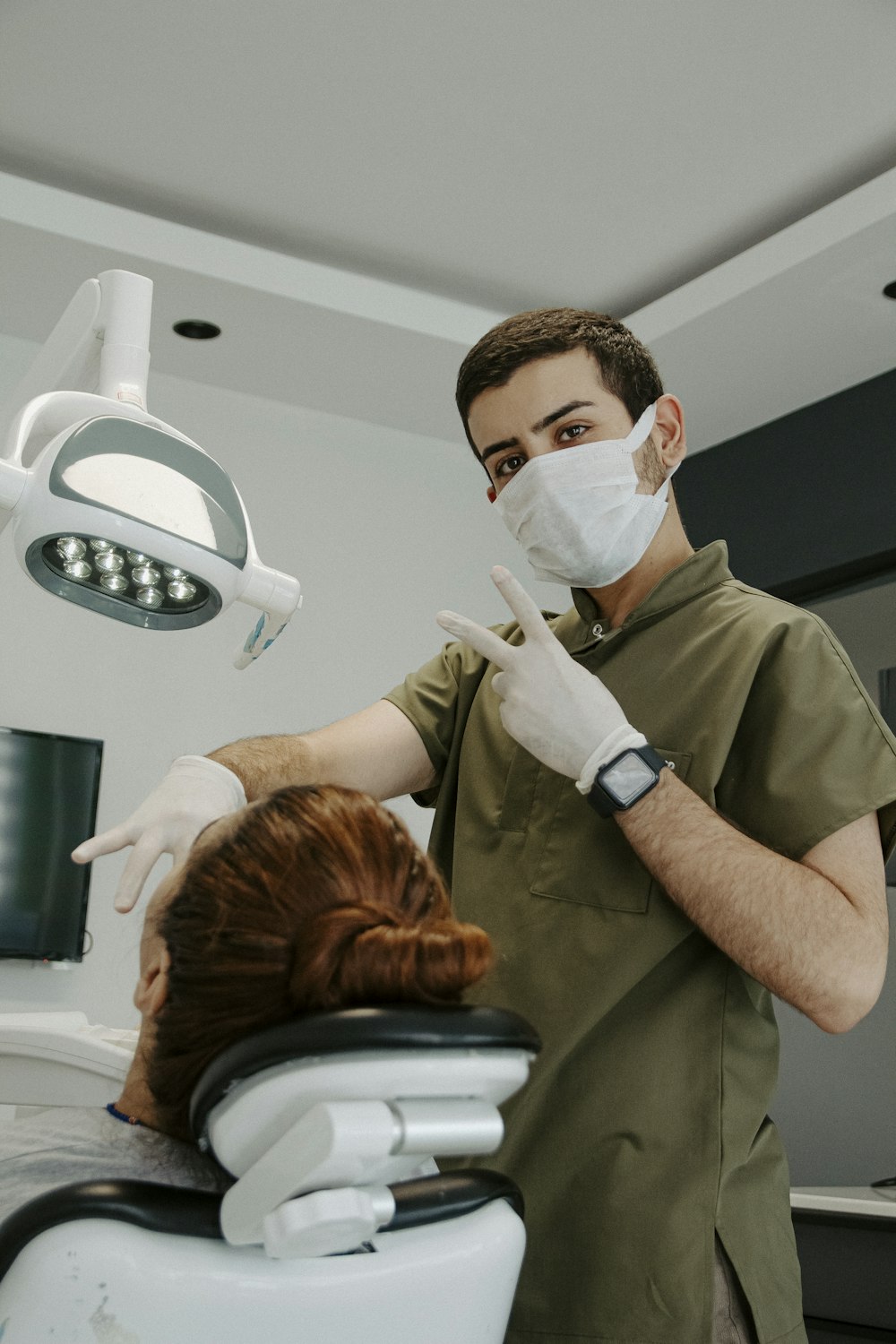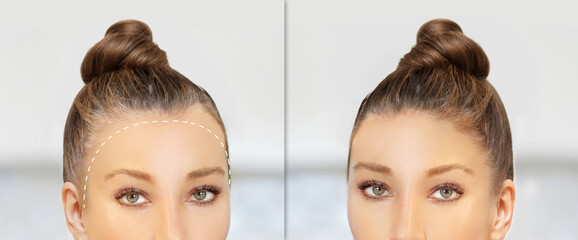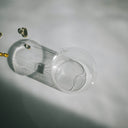People who want their hairline to be lower often don't like how big their forehead is.
For most of their lives, this problem has caused them a great deal of stress and shame. This sensitive topic could make people feel bad about themselves and embarrass them.
People who want their faces to look more balanced can use a surgical method that moves the hairline down.
So if you are planning hairline-lowering surgery, this article will tell you everything you need to know plus some better alternatives that don't cost a fortune to get.
This article will discuss how much forehead reduction surgery costs, what other options are available, etc. So let's start.
Table of content
What is hairline lowering surgery?

Hairline-lowering surgery aims to reduce the vertical gap between the brows. Since the process involves moving the hair-bearing scalp forward and securing a new hairline at a lower point on the forehead skin, it is also called a forehead reduction or scalp advancement. Most people who have surgery to reduce the size of their forehead are pleased with the results.
There are several positive aspects of surgically reducing the size of the forehead. First, it might make your hairline and facial features more symmetrical. When both surgical procedures are done on the same person, hairline-lowering surgery gives better and faster results than hair transplant procedure. In contrast to forehead reduction surgery, hair transplantation does not add more hair to the area where it was transplanted.
Read this: Hair Transplant Before And After: How Will I Look Post-Surgery?
As your leading source for hair health information over the past 4 years, we never compromise on accuracy. When it comes to your health, you deserve information you can truly rely on - and earning your trust is our top priority.
Here's how Scandinavian Biolabs ensures every piece of content meets the highest standards of accuracy and integrity:
- Credentialed Experts: Our reviewers are actively practicing doctors and medical researchers
- Stringent Reviews: Content undergoes rigorous editing by subject specialists and review by a practicing doctor.
- Evidence-Based: We rely on well-established research from trusted scientific sources like peer-reviewed journals and health authorities.
- Full Transparency: Our editorial standards, writer credentials, reviewer credentials, correction process, and funding are all publicly documented.
- Independent Voice: While we do promote products, we operate in a vacuum to business operations. Our main goal is just an unwavering commitment to providing medically-sound guidance.
You can count on Scandinavian Biolabs to consistently deliver the trustworthy health information you deserve. Read our Editorial Standards.
How does forehead reduction surgery work?

Procedure
Hairline lowering is a surgical procedure typically done while the patient is unconscious. Before the procedure, you and your surgeon will discuss the changes you want to make to your hairline. After your new hairline has been sketched, the plastic surgeon will make an incision and loosen the scalp tissues that produce hair. Before closing the incision, the skin will be brought forward by one to three centimeters, and any excess skin will be cut away.
Condition
If the scalp skin isn't flexible enough to be lowered to that level, the surgeon might suggest putting a tissue expander just below the scalp. The skin will be stretched progressively by the expander over six weeks. Once the skin has been stretched to the right length, the surgeon will finish the surgery by taking out the expander. A second treatment to decrease the hairline is another option.
Recovery
The recovery often takes less than an hour, and the incisions can be opened and the stitches removed in under a week. Hair washing is not advised until after stitches have been removed. Hair should start growing back in the scar within a few months. It will also help create a more natural hairline and conceal the scar.
How much can I lower my hairline?
The best distance between the hairline and the forehead is between 5 and 6.5 cm. For people with higher hairlines, lowering the hairline may be the best way to get a more balanced look. Additionally, the ideal candidate will have healthy skin with a high elasticity level.
What is recovery after hairline lowering like?
After medical procedures, many people are in pain, but painkillers can usually make these symptoms bearable. Mild to moderate swelling of the forehead is frequent. Most of the swelling goes away within the first few days and is completely gone within a week. Bruising is to be expected and will go away on its own after a week to ten days.
Follow the instructions for what to eat and how to care for yourself after surgery to minimize swelling and bruises more quickly. After 7 days, patients can return to work and light activities; however, they should cover the treated region with a scarf or loose-fitting cap. After a week, the sutures in the hairline can be taken out.
After two weeks, patients can resume normal activities such as working out and flying. Surgical hair loss can affect the scalp and linger for up to three months. Then, about 3 to 6 months after the surgery, hair starts to grow back through and in front of the cut, hiding the visible scar.
Types of hairline lowering surgery
Surgical hairline advancement
An incision is made in the front of the hairline for this surgery. The cuts made to move the hair forward and get rid of extra skin on the forehead are closed with sutures. The result is a thin incision scar along the hairline, which is meant to be covered by hair as it grows. This method involves more than just hair grafts to transplant hair, but it can be quite successful.
If done by a qualified medical professional, this treatment poses little to no risk to the patient. It's not common, but the dangers and difficulties are manageable when it does happen.
In addition, there are no hazards associated with general anesthesia because a hairline-lowering technique is done under local anesthesia and sedation.
Grafting hair

In common parlance, a "graft" is a thin skin artificially implanted with hair. Grafts can be harvested from virtually any area. However, the occipital scalp is where most of them come from because of its high sustainability. The technology, instruments, and surgical techniques determine the graft's dimensions and form.
Donor tissue is surgically excised to create hair grafts. The goal is to take a tiny bit of hair-bearing tissue from one part of the scalp and transplant it to another. Follicular unit transplantation (FUT) is a surgery in which a strip of tissue with hair is taken from the donor area and transplanted into the recipient area.
When doing FUT, stereoscopic dissecting microscopes remove grafts from the donor strip. These scalp follicles are preserved and prepared for transplantation. You'll find anywhere from two to four hairs in a normal follicular unit. First, the doctor will make incisions on the scalp that are the same size as the graft. The grafts are then carefully placed in the areas where they will grow so that they look like natural hair growth.
Follicular Unit Extraction (FUE) doesn't call for the removal of the donor's hair; therefore, there's no need to shave anyone's head bare. Instead, the follicular units are taken out of the scalp. Finally, the follicular units are harvested, frozen, and implanted into the scalp.
Read this: Stem Cell Hair Transplant: Know The Better Stem Cell Alternative
Who is a candidate for forehead reduction?

Those who are good candidates for hairline lowering have elastic skin along the scalp and are open to the chance of scarring. During your consultation, your doctor will assess your medical records and goals for the treatment to determine if you would be a good candidate for forehead reduction.
The procedure helps people with a high hairline or thinning hair get the look they want, and the hairline is often dropped by half an inch to an inch after excess skin is removed from the forehead.
However, it's important to understand that a scar at the hairline may be visible, even if the incision is made in a hidden location. With the help of a skilled plastic surgeon, hairline lowering can produce undetectable effects.
Is forehead reduction surgery painful?
Regarding pain, forehead reduction surgery often causes very little discomfort, if any at all. The majority of patients will have some level of mild discomfort the first evening after surgery. On the other hand, it's very rare for a patient to feel any serious pain. Patients are given prescribed pain medication to take as needed throughout treatment.
Read this: The 12 Best Natural and Drug Hair Transplant Alternatives
What are the possible complications?

There is always a chance of infection or other problems after surgery, but most people get better. It might work better for those who have low hair density.
- As the scalp is moved forward during hairline surgery, most patients often have swelling and bruises after the procedure. When a brow lift is done at the same time, there is also a greater chance that the bruises will go down to the eyes. Both issues are rather frequent and are typically resolved within a few days.
- When your hairline is lowered, you might lose hair temporarily or permanently around the scar. Most of the time, the temporary hair loss that happens right after the treatment is quickly replaced by new hair growth lasting up to four months.
- Many individuals report feeling numb in their forehead or scalp after cosmetic surgery. Typically, the underlying cause is an irreversible, small nerve injury. While annoying, itching and tingling sensations typically go away after a few months. There is a limited percentage of patients in whom numbness persists permanently. Such problems are rare, though, if the patient has chosen a skilled and experienced surgeon.
How much does hairline lowering surgery cost?
You can expect to pay more for this and other plastic surgery procedures in big cities because of the higher cost of living, which increases surgeons' operating costs. Suppose, though, that cost is more important to you than convenience. In this case, it's a good idea to talk to more than one expert surgeon whose office is small and in a good area so that you can get personalized price estimates and choose the best one. Some even give consultations at no cost.
Depending on some variables, the cost of a forehead reduction can vary from $4,000 to $13,500, with an average cost of $8,500. In addition, facelifts ($12,325), brow lifts ($7,225), and hair transplants ($7,250) are often done together with a forehead reduction. As a result, these additional cosmetic procedures will boost the overall price. But there is a chance that if you book them all at once, your supplier will give you a discount.
Is hairline-lowering surgery different from a hair transplant?
People born with naturally wide foreheads may also want to consider getting a hair transplant. Even though these individuals often do not have a receding hairline or uneven hairline, they may still want to consider having a hair grafting operation to add hairs to the front of their head to have a narrower forehead.
Suppose your hairline is too high, and you want to make your face look more balanced. In that case, the hairline-lowering procedure may give you more dramatic results and remove a much larger amount of hair in one surgery than hair transplantation would. Other things that can be changed are the density of the hair at the hairline and how the hair naturally falls out.
It doesn't matter if you're a man or a woman; the quality and quantity of your hair can be a source of significant stress and anxiety in social settings. Although both operations can help soothe your anxieties and change the shape of your hairline, these two procedures are very different.
Read this: 9 Effective Methods How To Regain Hair Loss From Stress
Alternatives to hairline lowering surgery
Reducing the prominence of the forehead is the primary goal of hairline-lowering surgery. This surgery, also known as a "forehead reduction," helps restore harmony to the face by lowering the scalp. A more viable alternative is hair transplantation. Although both sexes have access to the surgery, it may be more successful in women because the hairline doesn't recede as quickly as it does in men.
Here are some more alternatives to hairline-lowering surgery:
Scandinavian Biolabs Hair Growth Routine
To mitigate hair loss, you should use the Hair Growth Routine, which is made from plant-powered ingredients. It is crafted to increase circulation, allowing oxygen and nutrients to reach the scalp.
Our formula's ability to stimulate hair growth is based on a basic principle. With Capilia Longa being the major ingredient, it helps restore the normal hair growth cycle by stimulating the dermal papilla cells.
Clinical studies have shown that after 150 days of use of the formula, the hair growth cycle changes so that the hair stays longer in the anagen (growth) phase and spends the minimum time in the telogen (rest) phase. This means that the product works even if there are things we can't change, like our genes. So, the goal of the recipe is to give people naturally fuller hair since it takes longer to grow.
Minoxidil

Androgenetic baldness affects both men and women over the age of 18. Minoxidil applied to the scalp promotes hair growth in both men and women over the age of 18. The precise mechanism of action of these medicines has not yet been determined.
However, it is assumed that minoxidil will lead to hair growth. In that situation, results typically manifest after the medicine has been used for a few months and lasts only as long as it is being utilized. If you stop using Rogaine (minoxidil), your hair loss will start again in a few months.
You must adhere strictly to the prescribed dosage and duration of treatment. Please do not use it more often or in larger doses than prescribed. It's likely more easily absorbed that way.
Also, it would help if you didn't use minoxidil on your skin or nails. Absorption into the body may have unintended consequences for the cardiovascular system. Consult your doctor so they can familiarize you with the side effects and the alternatives to minoxidil.
Read this: Why You Should & Shouldn't Use Minoxidil After Hair Transplant?
Finasteride
Because hair loss and growth occur gradually over time, it may take at least 3 months of using finasteride for hair loss before you notice any difference. After that, you should see progress within the first year of treatment. If you've been taking finasteride for a year and are still waiting for results, taking it for another year probably won't help.
Discuss your options for continuing therapy with your doctor or try finasteride alternatives.
Finasteride can help reduce hair loss when used as directed, but it won't stop it entirely. Even if you feel better, you should keep taking finasteride. Always consult your doctor before taking finasteride. After stopping finasteride use, you will likely see some side effects and a resumption of hair loss.
PRP
Platelet-rich plasma is a solution made from a person's blood that is injected into, for example, an injured knee or tendon. Ultrasound may be used to help the doctor aim the injection. The goal is to speed up healing by increasing the amount of certain bioproteins or hormones called "growth factors" in the area.
PRP injections are used, but the exact method through which they work is still a mystery. Platelet-rich plasma, on the other hand, has a higher concentration of growth factors, which have been shown to speed up the healing process, reduce pain, and make hair grow faster.
Platelet-rich plasma (PRP) injections are a good way to treat male pattern baldness because they stop hair loss and make new hair grow. Platelet-rich plasma (PRP), which can be used after a successful hair transplant, can also help new hair grow.
How to find a qualified and skilled surgeon?
Consider the surgeon's affiliation with a hospital while making your decision. A reputable medical center will only employ highly qualified physicians. There is also the option of researching the physician's academic history.
Many doctors who practice at the best facilities in medical tourism hotspots were educated and trained extensively.
Also, before deciding on a certain doctor for treatment, it's important to know how confident you may feel in their medical knowledge, the procedures they specialize in, and their level of expertise in executing the treatment.
During the surgery, the plastic surgeons will figure out how much of the skin on the patient's forehead can be taken away without causing too much stretching. The skin on your forehead's pliability will determine this.
Then, the cosmetic surgeon takes a 1-2 inch wide piece of skin from the hairline and stitches it back in place. The backstitching step is fundamental to the entire operation. First, the right cosmetic surgeon must be chosen for the stitch to go in without a hitch. As a bonus, a skilled surgeon can cover up the scar formation with hair grafting.
Does hairline lowering surgery work?

Hairline-lowering surgery is an effective and subtle way to achieve a more aesthetically pleasing hairline. During the procedure, the hairline is incised along the front in a carefully planned manner, and then trimmed to create a lower line.
The amount of hairline lowering depends on how much of the forehead needs to be exposed and what kind of look the patient desires.
Depending on the amount and type of hair, a hairline lowering procedure can be completed in one to three hours under local or general anesthesia. The results of the surgery are usually visible after two weeks, but it can take up to a year for the full effects to appear.
In most cases, the results are long-lasting and natural looking. The surgeon will typically advise on the best course of action to ensure a successful outcome with minimal scarring.
In some instances, hairline lowering surgery can be combined with other procedures such as forehead elevation and brow lift for a more comprehensive aesthetic improvement.
Read more:






